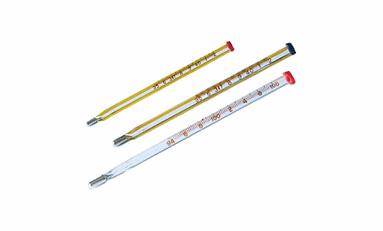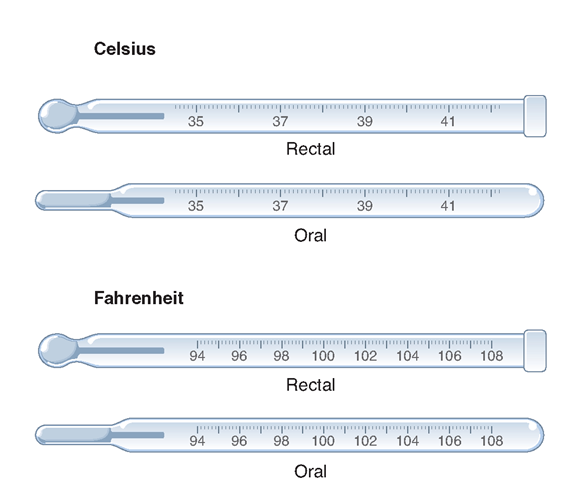

COVID-19 drugs: Are there any that work?.In: Wong's Nursing Care of Infants and Children. Communication, physical and developmental assessment. American College of Emergency Physicians. Clinical report - Fever and antipyretic use in children. In: Roberts and Hedges' Clinical Procedures in Emergency Medicine and Acute Care. Fever in infants and children: Pathophysiology and management. In: Rosen's Emergency Medicine: Concepts and Clinical Practice. Gently place it in the ear canal no further than indicated by the instructions that came with the device.

 Hold the thermometer tightly in place until you hear the thermometer beep indicating it's done. Place the thermometer under the armpit, making sure it touches skin, not clothing. Gently sweep it across the forehead and read the number. Close the mouth around the thermometer for the recommended amount of time or until the thermometer beep indicates it's done. Place the thermometer tip under the tongue. Remove the thermometer and read the number. To avoid injury, don't let go of the thermometer while it's inside the child. Hold the thermometer and child still until the thermometer beep indicates it's done. Carefully insert the tip 1/2 to 1 inch (1.3 to 2.5 centimeters) into the rectum. Lay the child on his or her stomach or side, with knees flexed. Turn on the digital thermometer and dab petroleum jelly or another lubricant on the tip of the thermometer. Never leave a child unattended while taking his or her temperature. Don't use the same thermometer for both oral and rectal temperatures. Clean the thermometer before and after each use with rubbing alcohol or soap and lukewarm water. Read the instructions that came with the thermometer. No matter which type of thermometer you use, take these precautions when using it: Armpit (axillary) and ear (tympanic membrane) thermometers, which are less accurate.īecause of the potential for mercury exposure or ingestion, glass mercury thermometers have been phased out and are no longer recommended. Temporal artery thermometers use an infrared scanner to measure the temperature of the temporal artery in the forehead. Oral thermometers are used in the mouth. Rectal thermometers are used in the rectum. Any worrisome, different or unusual symptomsĪlways use a digital thermometer to check someone's temperature. Seek emergency medical care if your child has a fever after being left in a hot car or involved in another such potentially dangerous situation and shows any of these warning signs: Pain with urination or pain in the back. Dry mouth, decreased or dark urine, or refusal to drink fluids, which may indicate dehydration. Seek medical care if someone with a fever has any of the following signs and symptoms: Take acetaminophen (Tylenol, others) or ibuprofen (Advil, Motrin IB, others). Use a light blanket if you feel chilled, until the chills end. Drink plenty of fluids to stay hydrated. The main goal of treatment is to relieve discomfort and help you get rest. Treating fever in an adultĪdults with fevers of 103 F (39.4 C) or higher will generally look and act sick. Signs and symptoms of dehydration, such as no wet diapers over eight to 10 hours, crying without tears, a dry mouth or refusing to drink any fluidsĪlso get medical help if the fever lasts more than five days in a row. Fussiness, or acting abnormally, which doesn't improve even after taking medications to bring down the fever.
Hold the thermometer tightly in place until you hear the thermometer beep indicating it's done. Place the thermometer under the armpit, making sure it touches skin, not clothing. Gently sweep it across the forehead and read the number. Close the mouth around the thermometer for the recommended amount of time or until the thermometer beep indicates it's done. Place the thermometer tip under the tongue. Remove the thermometer and read the number. To avoid injury, don't let go of the thermometer while it's inside the child. Hold the thermometer and child still until the thermometer beep indicates it's done. Carefully insert the tip 1/2 to 1 inch (1.3 to 2.5 centimeters) into the rectum. Lay the child on his or her stomach or side, with knees flexed. Turn on the digital thermometer and dab petroleum jelly or another lubricant on the tip of the thermometer. Never leave a child unattended while taking his or her temperature. Don't use the same thermometer for both oral and rectal temperatures. Clean the thermometer before and after each use with rubbing alcohol or soap and lukewarm water. Read the instructions that came with the thermometer. No matter which type of thermometer you use, take these precautions when using it: Armpit (axillary) and ear (tympanic membrane) thermometers, which are less accurate.īecause of the potential for mercury exposure or ingestion, glass mercury thermometers have been phased out and are no longer recommended. Temporal artery thermometers use an infrared scanner to measure the temperature of the temporal artery in the forehead. Oral thermometers are used in the mouth. Rectal thermometers are used in the rectum. Any worrisome, different or unusual symptomsĪlways use a digital thermometer to check someone's temperature. Seek emergency medical care if your child has a fever after being left in a hot car or involved in another such potentially dangerous situation and shows any of these warning signs: Pain with urination or pain in the back. Dry mouth, decreased or dark urine, or refusal to drink fluids, which may indicate dehydration. Seek medical care if someone with a fever has any of the following signs and symptoms: Take acetaminophen (Tylenol, others) or ibuprofen (Advil, Motrin IB, others). Use a light blanket if you feel chilled, until the chills end. Drink plenty of fluids to stay hydrated. The main goal of treatment is to relieve discomfort and help you get rest. Treating fever in an adultĪdults with fevers of 103 F (39.4 C) or higher will generally look and act sick. Signs and symptoms of dehydration, such as no wet diapers over eight to 10 hours, crying without tears, a dry mouth or refusing to drink any fluidsĪlso get medical help if the fever lasts more than five days in a row. Fussiness, or acting abnormally, which doesn't improve even after taking medications to bring down the fever. 
Seek medical care if a child of any age shows any of the following: If your baby is less than 3 months old and has a fever, it's important to get medical help immediately. Read the label carefully for proper dosing. If your child is 6 months old or older, give your child acetaminophen (Tylenol, others) or ibuprofen (Advil, Motrin, others).Don't give an infant any type of pain reliever until after you've contacted a doctor and your child has been evaluated.Don't give aspirin to children or teenagers.Use a light blanket if your child feels chilled, until the chills end.Dress your child in lightweight clothing.If your child is uncomfortable or restless, these home care strategies may help: Treating a fever depends on the degree of discomfort. Treating fever in a childĬhildren with relatively high fevers may not look or act particularly sick. Treating a fever neither shortens nor particularly prolongs the course of an illness. When you or your child is sick, the main goal is to relieve discomfort and promote rest. Armpit temperature of 99 F (37.2 C) or higher.Oral temperature of 100 F (37.8 C) or higher.Rectal, ear or temporal artery temperature of 100.4 (38 C) or higher.The following thermometer readings generally indicate a fever:








 0 kommentar(er)
0 kommentar(er)
